The Role of Solar Gains in Net-Zero Energy Buildings: Evaluating and Optimising the Design of Shading Elements as Passive Cooling Strategies in Single-Family Buildings in Colombia
Abstract
1. Introduction
1.1. NZEBs in Tropical and Equatorial Areas
1.2. Objectives and Research Questions
- Firstly, a representative residential building is selected, and a monitoring study is carried out, with the aim of obtaining relevant data regarding its indoor thermal conditions.
- Secondly, a building simulation model is defined, validated and calibrated with the data obtained from the monitoring study.
- Finally, the model is used to design and evaluate a set of different strategies with the aim of evaluating their impact, considering both the cooling demand and indoor comfort, not only assuming different orientations and locations (representative of the different Colombian climates) but also considering one of the future climate scenarios projected by the IPCC. Thus, 960 different combinations were simulated under two different approaches (resulting, then, in 1920 simulations), and the obtained results were carefully analysed. Additionally, these results are publicly available in a data set stored in Mendeley Data Repository [16].
- RQ1. What is the optimal design of different shading solutions for latitudes close to the equator?
- RQ2. What impacts do orientation and location have on the design of these strategies?
- RQ3. What impact do these measures have in terms of cooling demand reduction and thermal comfort?
2. Materials and Methods
2.1. Case Study: A Terraced House in Bucaramanga, Colombia
2.2. Monitoring Study
2.2.1. Monitoring Equipment and Sensor Placement
- Outdoor sensors: Three sensors were installed to monitor environmental conditions. Two were located on the eastern façade to capture morning solar gains, with one on the western façade to measure the effects of afternoon solar exposure.
- Indoor sensors: Five sensors were positioned within the building. One was on the ground floor, one sensor was placed in an east-facing room to record morning thermal gains, one was in a west-facing room to monitor afternoon heat effects, and another was in a centrally located room to establish baseline conditions. On the upper floor, one sensor was located in an east-facing bedroom and another in a west-facing bedroom to capture vertical stratification and room-specific dynamics.
2.2.2. Monitoring Campaign
2.2.3. Measurement Parameters and Spatial Configuration
- Zone 1: the entire ground floor, including east-facing, west-facing, and central rooms (even though three sensors were placed on the ground floor (two in the living room and one in the bedroom), the measured temperature profiles were quite similar, and only one zone was considered to make the analysis clearer, assuming a profile obtained from the average values measured by the three sensors);
- Zone 2: east-facing rooms on the upper floor;
- Zone 3: west-facing rooms on the upper floor.
2.2.4. Analysis Framework
3. Building Modelling and Definition of Scenarios
3.1. Model Definition
3.2. Model Validation
3.3. Scenarios Evaluated
3.3.1. Louvers
3.3.2. Overhangs (Windows)
3.3.3. Overhangs (Façade)
3.3.4. Side Fins
3.3.5. Combinations Evaluated
3.4. Extrapolation of Results to Other Conditions: Different Orientations and Climates
3.5. Design of Simulations
- A Python script modified the .idf files iteratively for each scenario, accounting for orientation and building location. Simulations were then conducted for each iteration.
- The simulation outputs were processed and compiled into spreadsheets containing monthly cooling demands and the total annual cooling demand (in kWh) for each simulated case.
3.6. Data Analysis
4. Results and Discussion
4.1. Cooling Demand
4.2. Indoor Comfort Analysis
4.3. Future Climate Scenarios
5. Conclusions and Future Works
Author Contributions
Funding
Institutional Review Board Statement
Informed Consent Statement
Data Availability Statement
Acknowledgments
Conflicts of Interest
References
- Vélez-Henao, J.A.; Pauliuk, S. Pathways to a Net Zero Building Sector in Colombia: Insights from a Circular Economy Perspective. Resour. Conserv. Recycl. 2025, 212, 107971. [Google Scholar] [CrossRef]
- Ibrahim, M.; Harkouss, F.; Biwole, P.; Fardoun, F.; Ouldboukhitine, S. Building Retrofitting towards Net Zero Energy: A Review. Energy Build. 2024, 322, 114707. [Google Scholar] [CrossRef]
- IPCC. Intergovernmental Panel on Climate Change Climate Change 2022: Impacts, Adaptation and Vulnerability. Contribution of Working Group II to the Sixth Assessment Report of the Intergovernmental Panel on Climate Change; Pörtner, H.-O., Roberts, D.C., Tignor, M., Poloczanska, E.S., Mintenbeck, K., Alegría, A., Craig, M., Langsdorf, S., Löschke, S., Möller, V., et al., Eds.; Cambridge University Press: Cambridge, UK; New York, NY, USA, 2022. [Google Scholar]
- Medina, J.M.; Rodriguez, C.M.; Coronado, M.C.; Garcia, L.M. Scoping Review of Thermal Comfort Research in Colombia. Buildings 2021, 11, 232. [Google Scholar] [CrossRef]
- Ríos-Ocampo, J.P.; Olaya, Y.; Osorio, A.; Henao, D.; Smith, R.; Arango-Aramburo, S. Thermal Districts in Colombia: Developing a Methodology to Estimate the Cooling Potential Demand. Renew. Sustain. Energy Rev. 2022, 165, 112612. [Google Scholar] [CrossRef]
- Balbis-Morejón, M.; Cabello-Eras, J.J.; Rey-Martínez, F.J.; Fandiño, J.M.; Rey-Hernández, J.M. Energy Performance of a University Building for Different Air Conditioning (AC) Technologies: A Case Study. Buildings 2024, 14, 1746. [Google Scholar] [CrossRef]
- Valladares-Rendón, L.G.; Schmid, G.; Lo, S.-L. Review on Energy Savings by Solar Control Techniques and Optimal Building Orientation for the Strategic Placement of Façade Shading Systems. Energy Build. 2017, 140, 458–479. [Google Scholar] [CrossRef]
- Khourchid, A.M.; Ajjur, S.B.; Al-Ghamdi, S.G. Building Cooling Requirements under Climate Change Scenarios: Impact, Mitigation Strategies, and Future Directions. Buildings 2022, 12, 1519. [Google Scholar] [CrossRef]
- Bhamare, D.K.; Rathod, M.K.; Banerjee, J. Passive Cooling Techniques for Building and Their Applicability in Different Climatic Zones—The State of Art. Energy Build. 2019, 198, 467–490. [Google Scholar] [CrossRef]
- Al-Masrani, S.M.; Al-Obaidi, K.M.; Zalin, N.A.; Aida Isma, M.I. Design Optimisation of Solar Shading Systems for Tropical Office Buildings: Challenges and Future Trends. Sol. Energy 2018, 170, 849–872. [Google Scholar] [CrossRef]
- Chi, D.A.; González, M.E.; Valdivia, R.; Gutiérrez, J.E. Parametric Design and Comfort Optimization of Dynamic Shading Structures. Sustainability 2021, 13, 7670. [Google Scholar] [CrossRef]
- López-Guerrero, R.E.; Cruz, A.S.; Hong, T.; Carpio, M. Optimizing Urban Housing Design: Improving Thermo-Energy Performance and Mitigating Heat Emissions from Buildings—A Latin American Case Study. Urban Clim. 2024, 57, 102119. [Google Scholar] [CrossRef]
- Wong, S.L.; Wan, K.K.W.; Li, D.H.W.; Lam, J.C. Impact of Climate Change on Residential Building Envelope Cooling Loads in Subtropical Climates. Energy Build. 2010, 42, 2098–2103. [Google Scholar] [CrossRef]
- Camporeale, P.E.; Mercader-Moyano, P. Towards Nearly Zero Energy Buildings: Shape Optimization of Typical Housing Typologies in Ibero-American Temperate Climate Cities from a Holistic Perspective. Sol. Energy 2019, 193, 738–765. [Google Scholar] [CrossRef]
- Valle-Garcia, A.; Lozano-Bustamante, S.; Camargo-Caicedo, Y. Spatial and Temporal Variability of Temperature, Precipitation, and Solar Radiation in Magdalena Department, Colombia from 2000 to 2022. Heliyon 2024, 10, e38372. [Google Scholar] [CrossRef] [PubMed]
- Ascanio Villabona, J.; Álvarez-Sanz, M.; Azkorra-Larrinaga, Z.; Terés-Zubiaga, J. The Role of Solar Gains in Net-Zero Energy Buildings: Evaluating and Optimising the Design of Shading Elements as Passive Cooling Strategies in Single Family Buildings in Colombia—Associated Research Data; Mendeley Data: London, UK, 2024. [Google Scholar]
- IDEAM. Instituto de Hidrología, Meteorología y Asuntos Ambientales Catalogo Estaciones IDEAM. Available online: https://www.datos.gov.co/Ambiente-y-Desarrollo-Sostenible/Cat-logo-Nacional-de-Estaciones-del-IDEAM/hp9r-jxuu/about_data (accessed on 21 January 2025).
- Design Builder. DesignBuilder Software Ltd.: Stroud, UK. Available online: https://designbuilder.co.uk/ (accessed on 21 January 2025).
- Energy Plus. US-DOE: Washington, DC, USA. Available online: https://energyplus.net/ (accessed on 21 January 2025).
- Anđelković, A.S.; Mujan, I.; Dakić, S. Experimental Validation of a EnergyPlus Model: Application of a Multi-Storey Naturally Ventilated Double Skin Façade. Energy Build. 2016, 118, 27–36. [Google Scholar] [CrossRef]
- Mateus, N.M.; Pinto, A.; Graça, G.C. da Validation of EnergyPlus Thermal Simulation of a Double Skin Naturally and Mechanically Ventilated Test Cell. Energy Build. 2014, 75, 511–522. [Google Scholar] [CrossRef]
- Zhou, Y.P.; Wu, J.Y.; Wang, R.Z.; Shiochi, S.; Li, Y.M. Simulation and Experimental Validation of the Variable-Refrigerant-Volume (VRV) Air-Conditioning System in EnergyPlus. Energy Build. 2008, 40, 1041–1047. [Google Scholar] [CrossRef]
- Álvarez-Sanz, M.; Satriya, F.A.; Terés-Zubiaga, J.; Campos-Celador, A.; Bermejo, U. Ranking Building Design and Operation Parameters for Residential Heating Demand Forecasting with Machine Learning. J. Build. Eng. 2024, 86, 108817. [Google Scholar] [CrossRef]
- Rodríguez-Pertuz, M.L.; Terés-Zubiaga, J.; Campos-Celador, A.; González-Pino, I. Feasibility of Zonal Space Heating Controls in Residential Buildings in Temperate Climates: Energy and Economic Potentials in Spain. Energy Build. 2020, 218, 110006. [Google Scholar] [CrossRef]
- IPCC. Intergovernmental Panel on Climate Change Climate Change 2014: Synthesis Report. Contribution of Working Groups I, II and III to the Fifth Assessment Report of the Intergovernmental Panel on Climate Change; Core Writing Team, Pachauri, R.K., Meyer, L.A., Eds.; IPCC: Geneva, Switzerland, 2014. [Google Scholar]
- Santosh, P. Eppy—Scripting Language for EnergyPlus idf Files, and EnergyPlus Output Files. 2013. Available online: https://eppy.readthedocs.io/en/latest/index.html (accessed on 22 September 2023).
- Bull, J. GeomEppy. 2016. Available online: https://github.com/jamiebull1/geomeppy (accessed on 22 September 2023).
- R Core Team. R: A Language and Environment for Statistical Computing; R Foundation for Statistical Computing: Vienna, Austria, 2024; Available online: https://www.R-project.org/ (accessed on 21 January 2025).
- de Mendiburu, F. Agricolae: Statistical Procedures for Agricultural Research. R Package Version 1.3-7. 2023. Available online: https://CRAN.R-project.org/package=agricolae (accessed on 21 January 2025).
- Cecilia González, O. Metodología Para El Calculo Del Confort Climático En Colombia; Instituto De Hidrologia, Meteorologia Y Estudios Ambientales—IDEAM: Bogotá, Colombia, 1998. [Google Scholar]
- Espín-Sánchez, D.; Olcina-Cantos, J.; Conesa-García, C. Temporal Changes in Tourists’ Climate-Based Comfort in the Southeastern Coastal Region of Spain. Climate 2023, 11, 230. [Google Scholar] [CrossRef]
- Sievert, C. Interactive Web-Based Data Visualization with R, Plotly and Shiny; Chapman and Hall/CRC: Boca Raton, FL, USA, 2020. [Google Scholar]
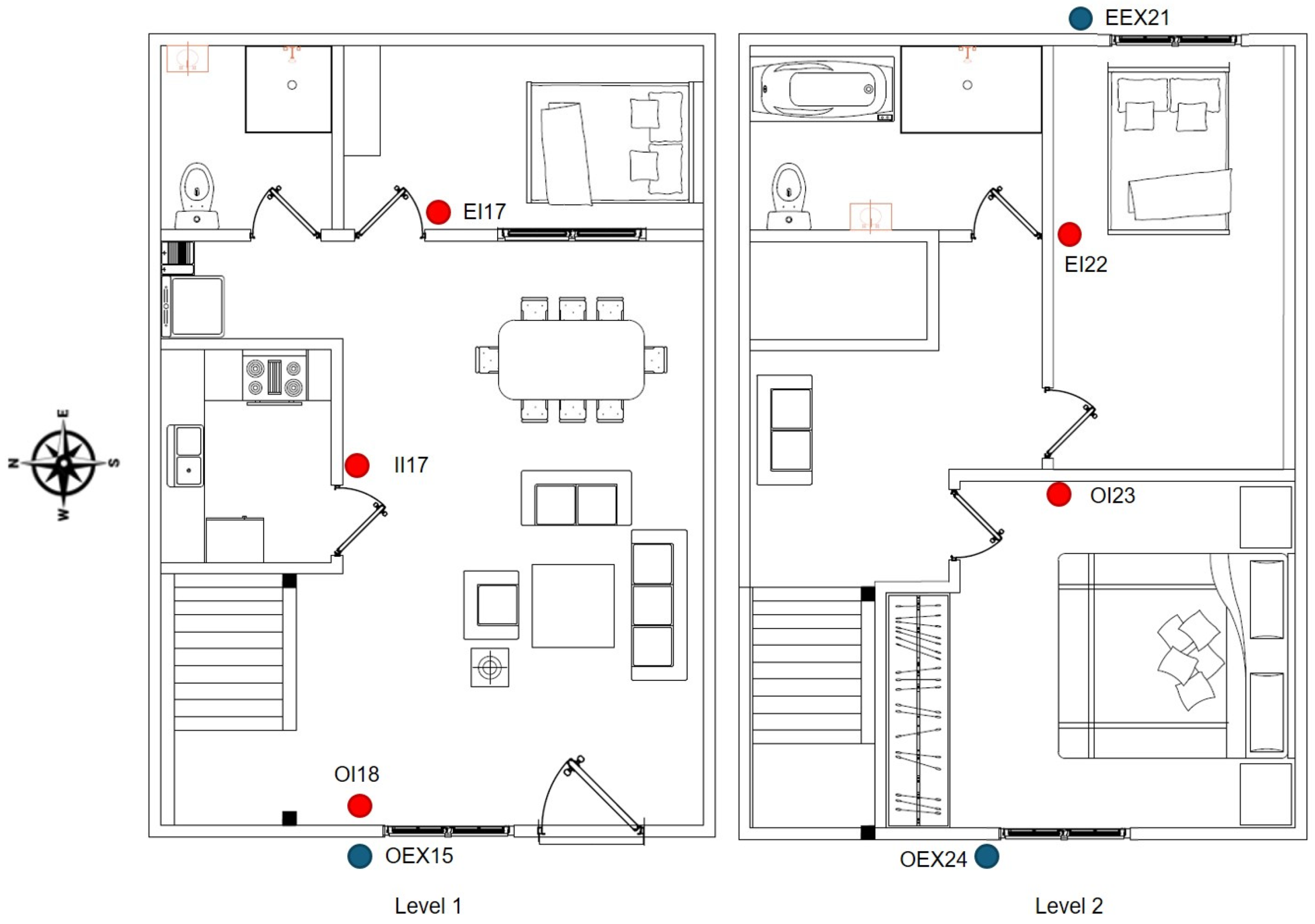
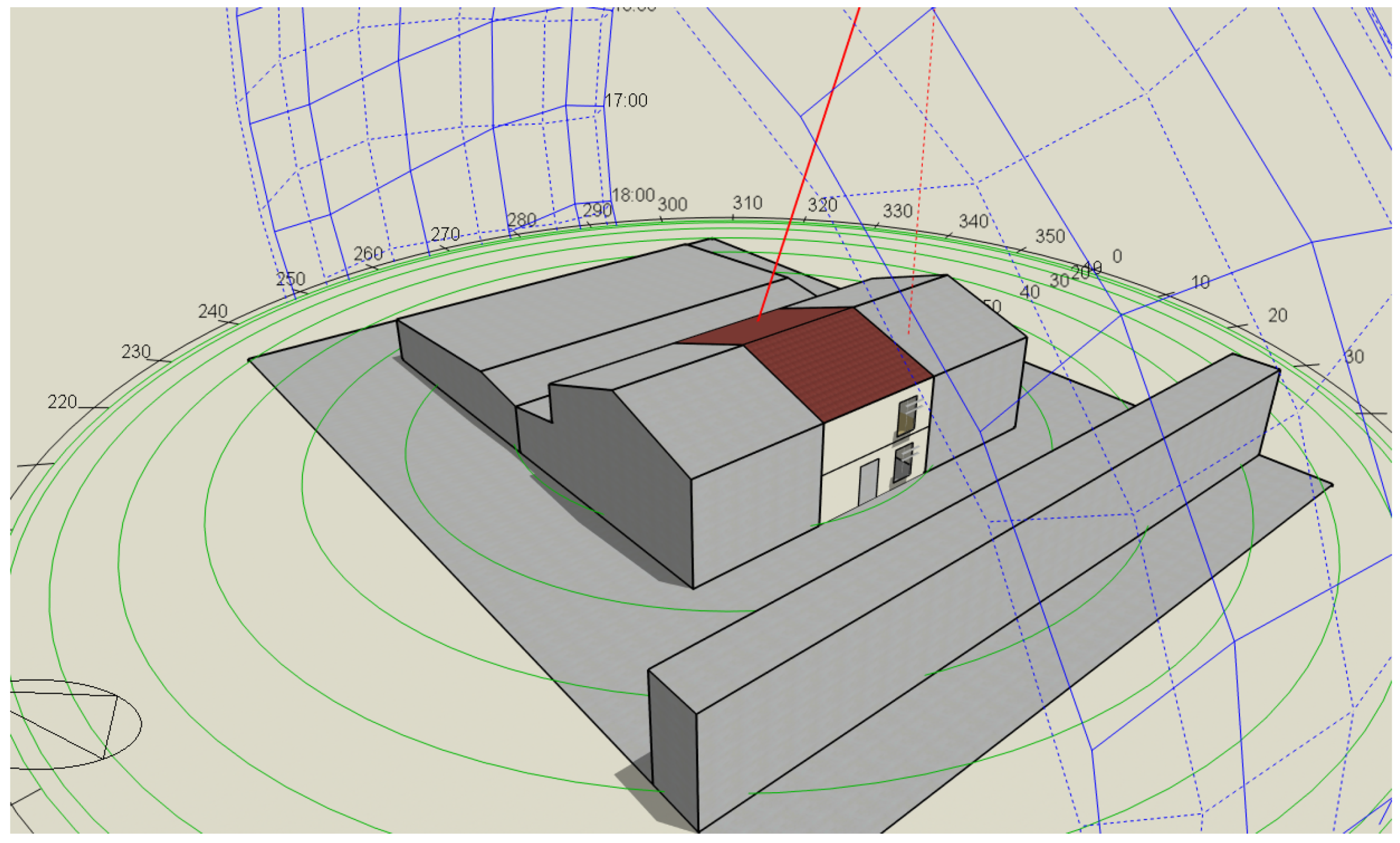
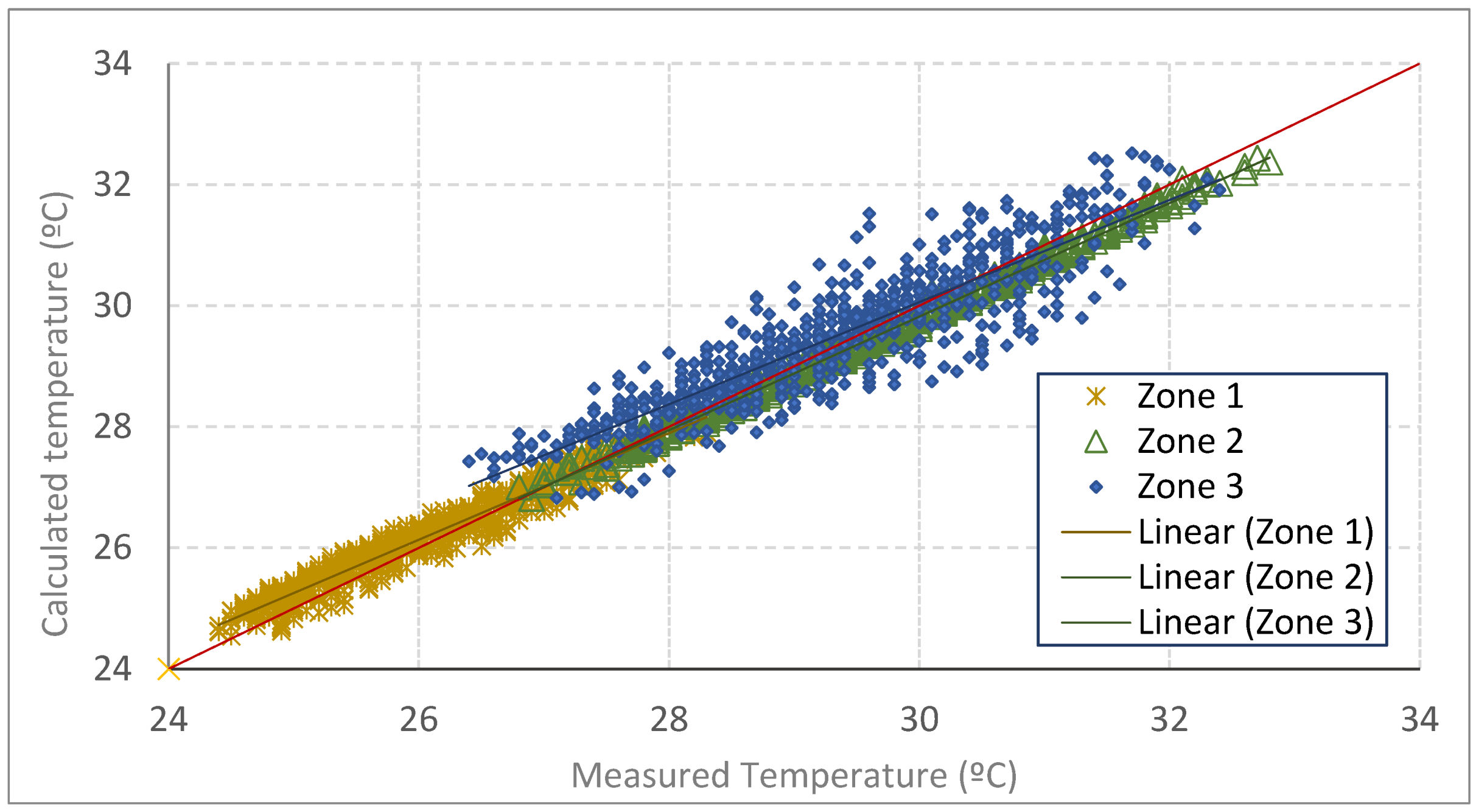
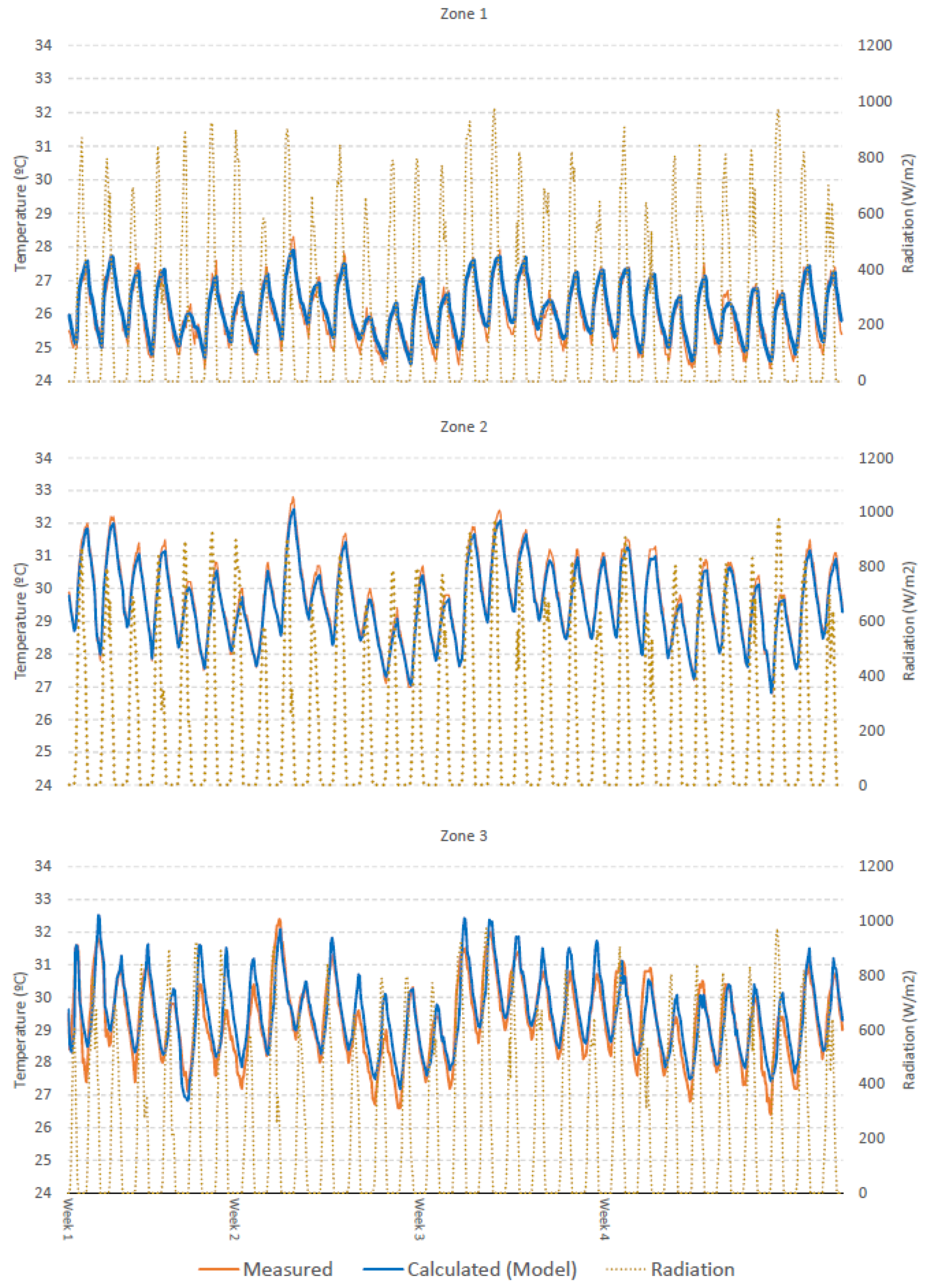




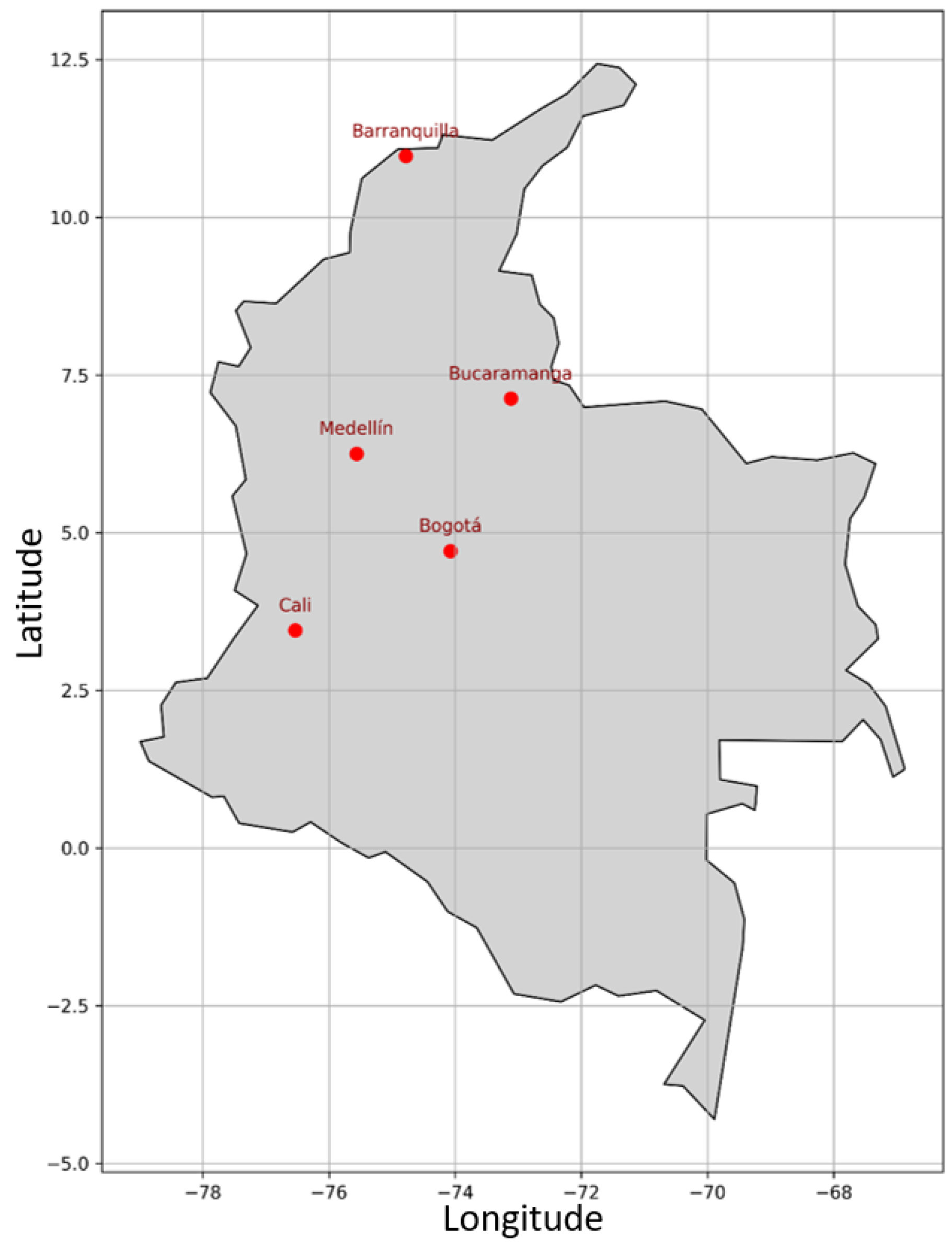
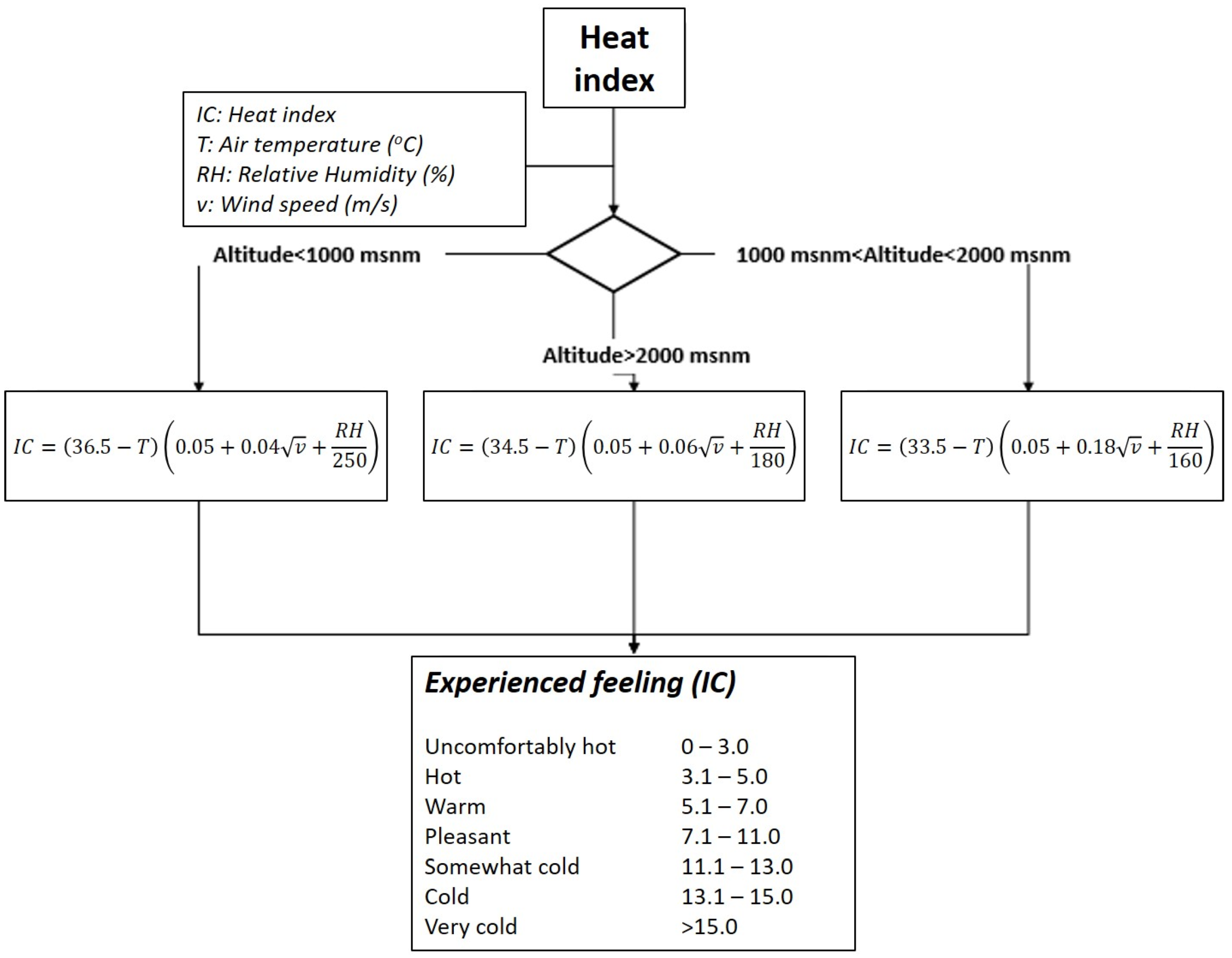
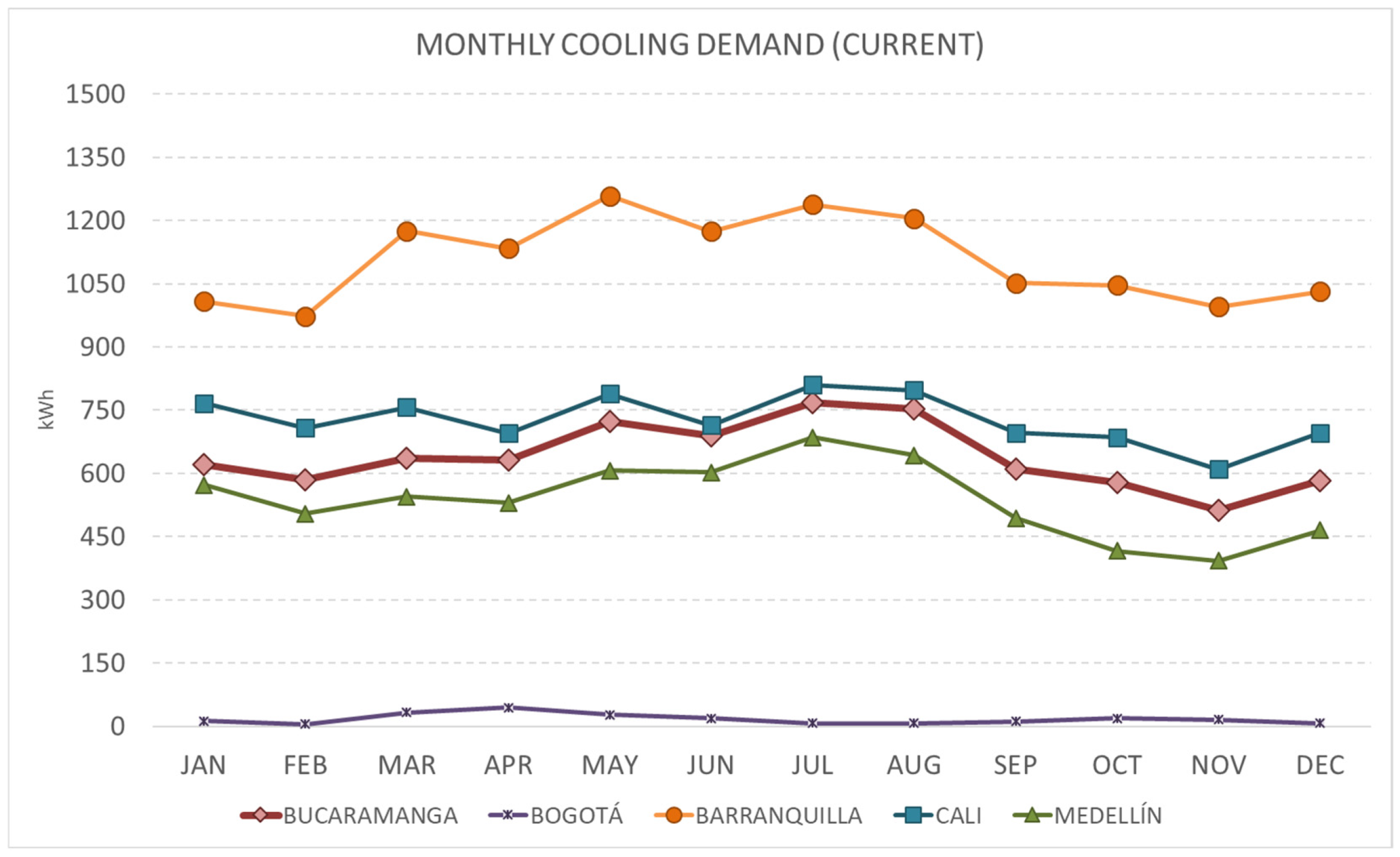
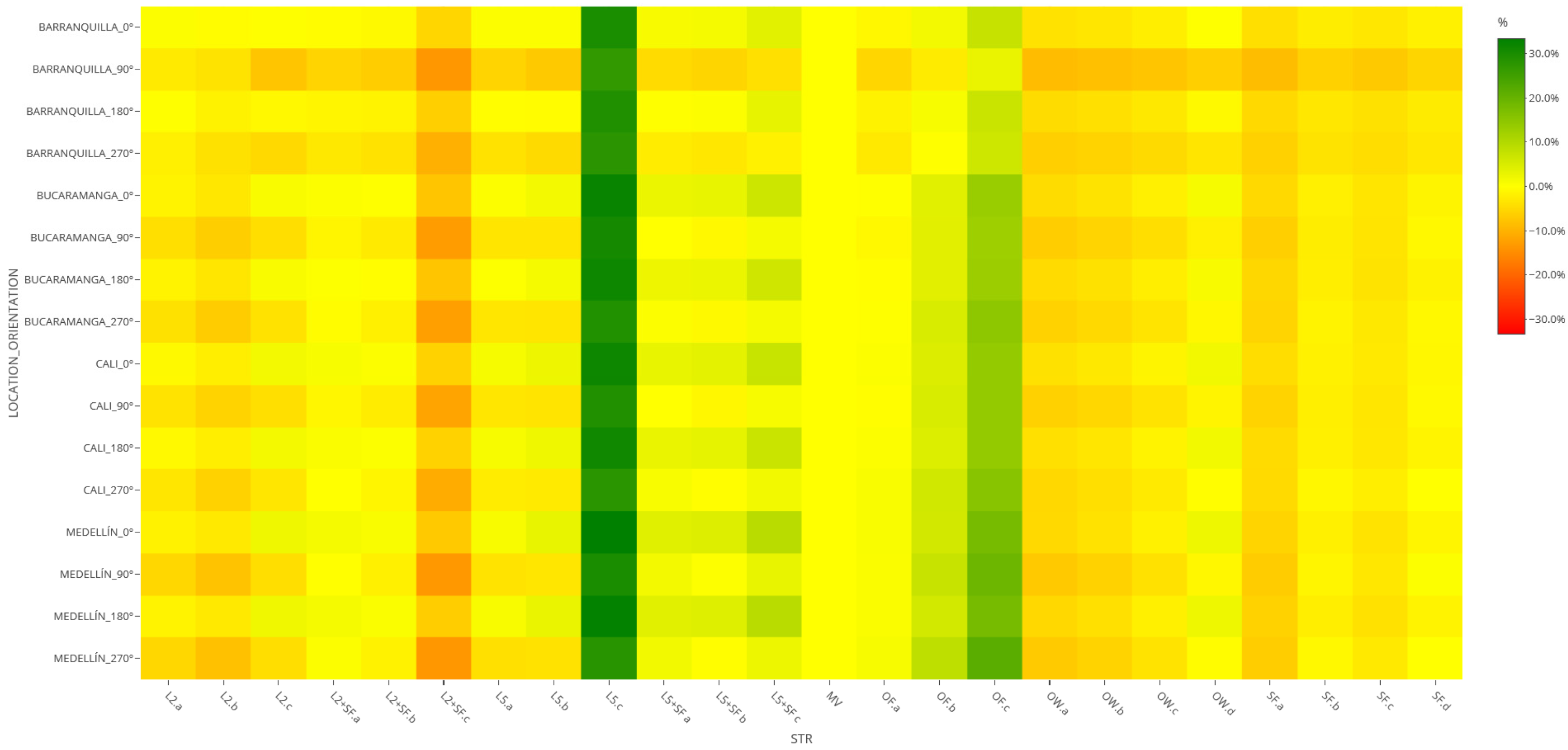
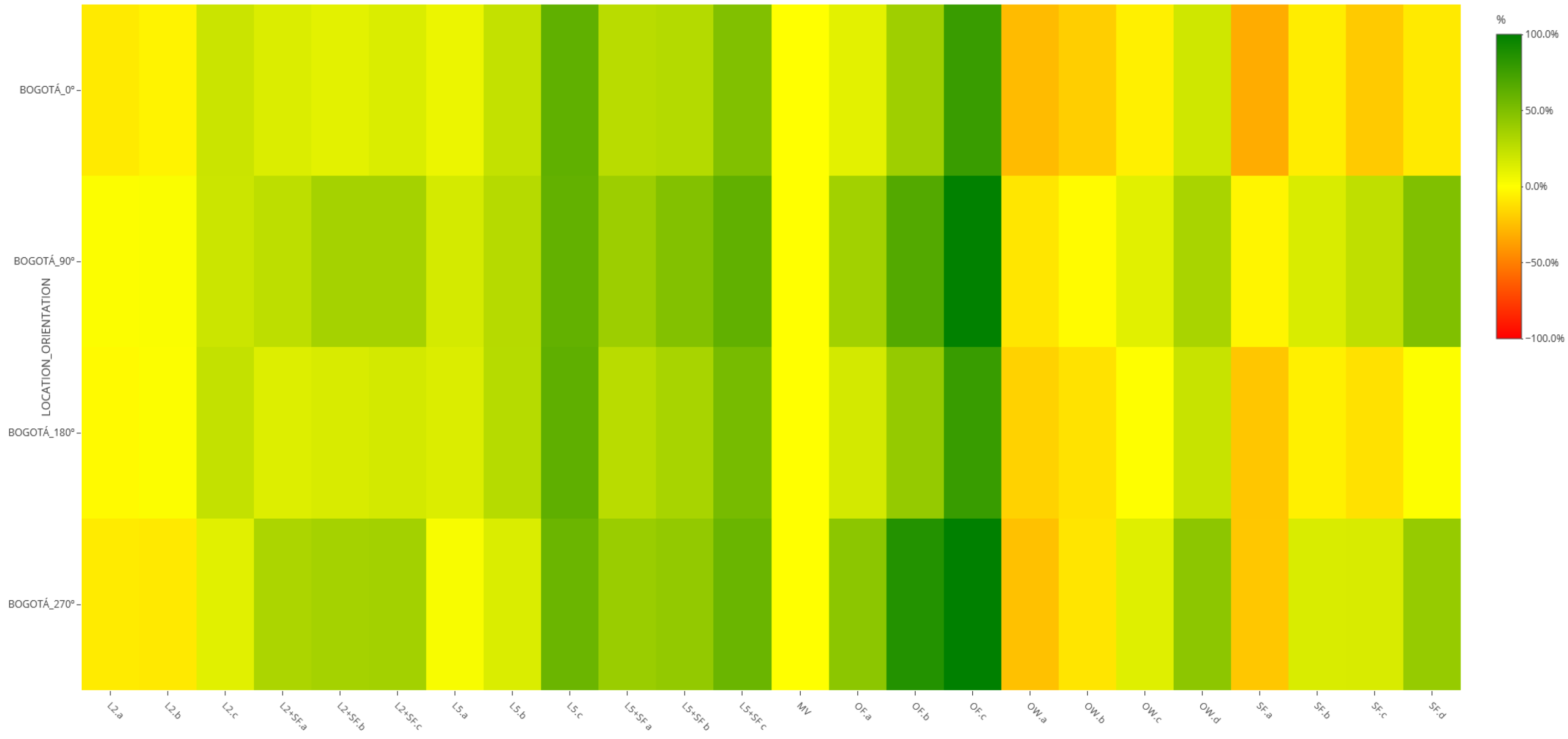
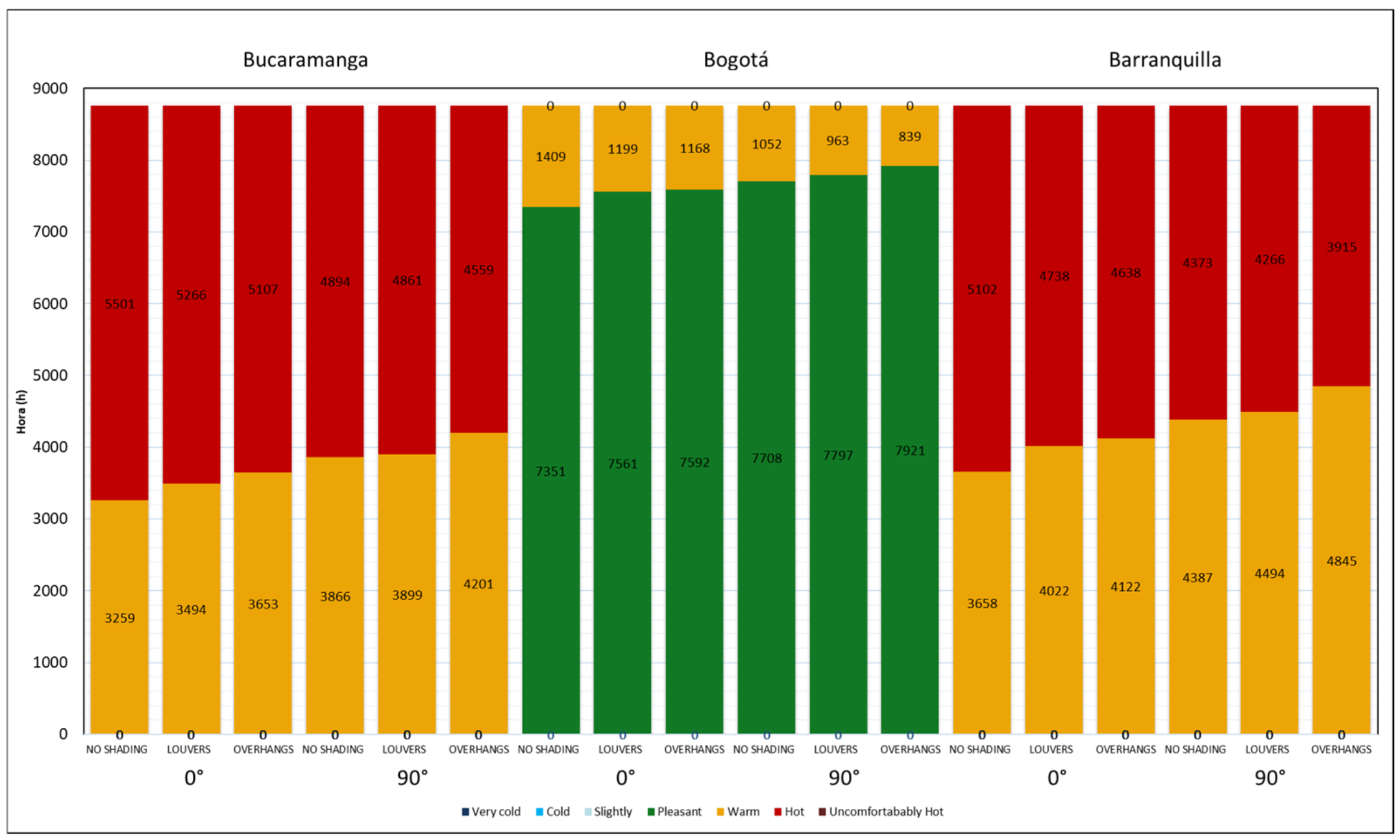
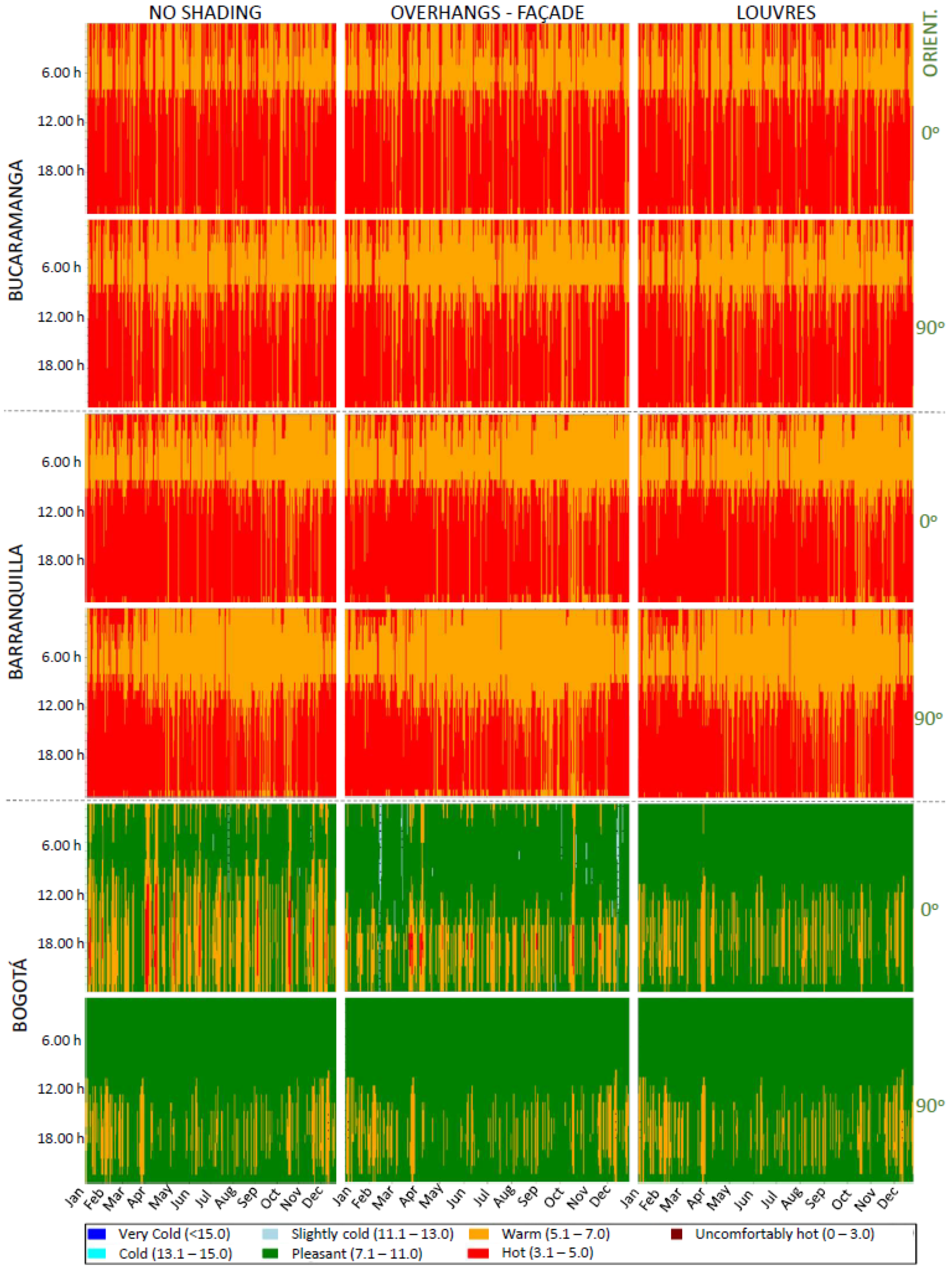
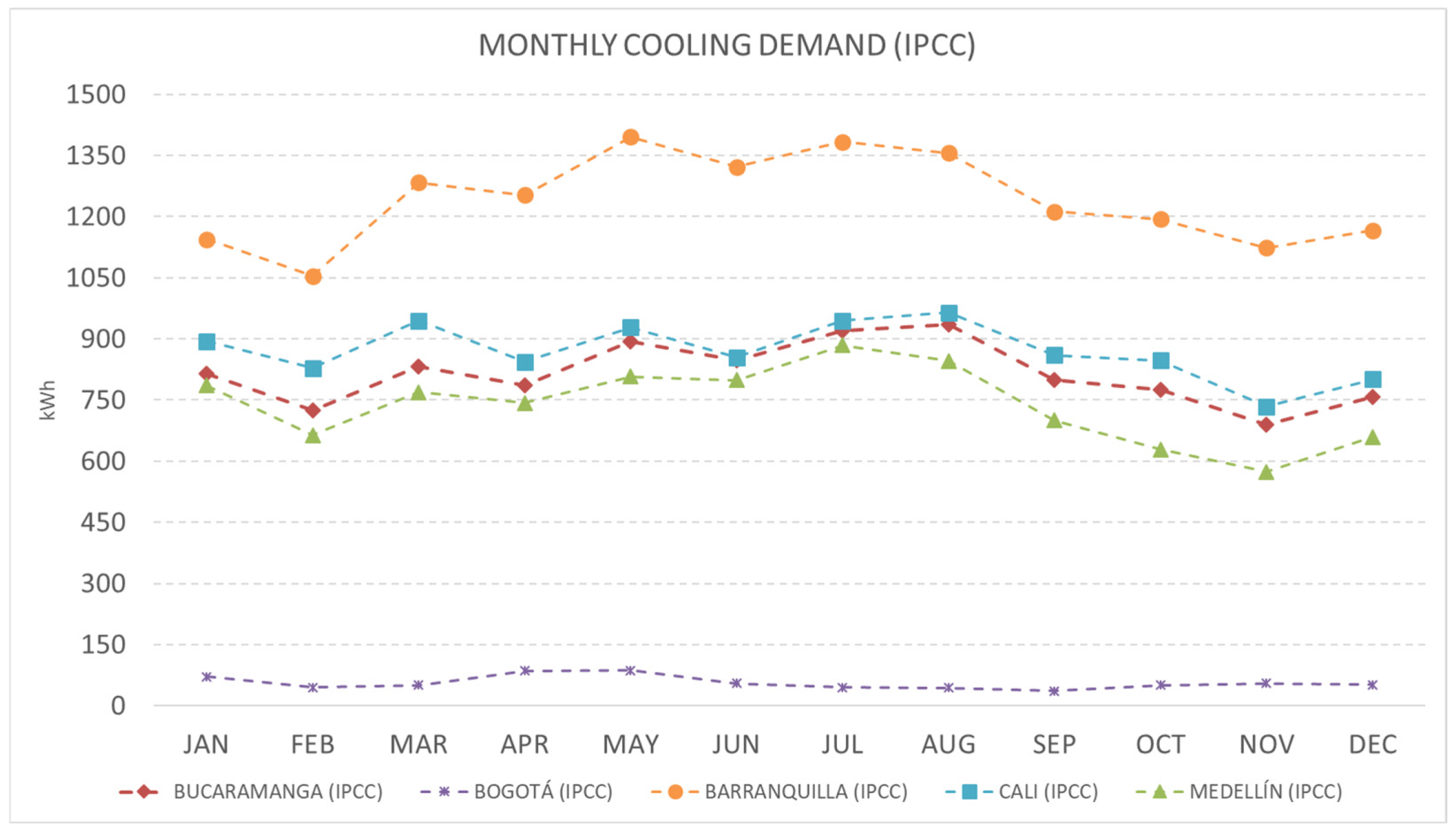
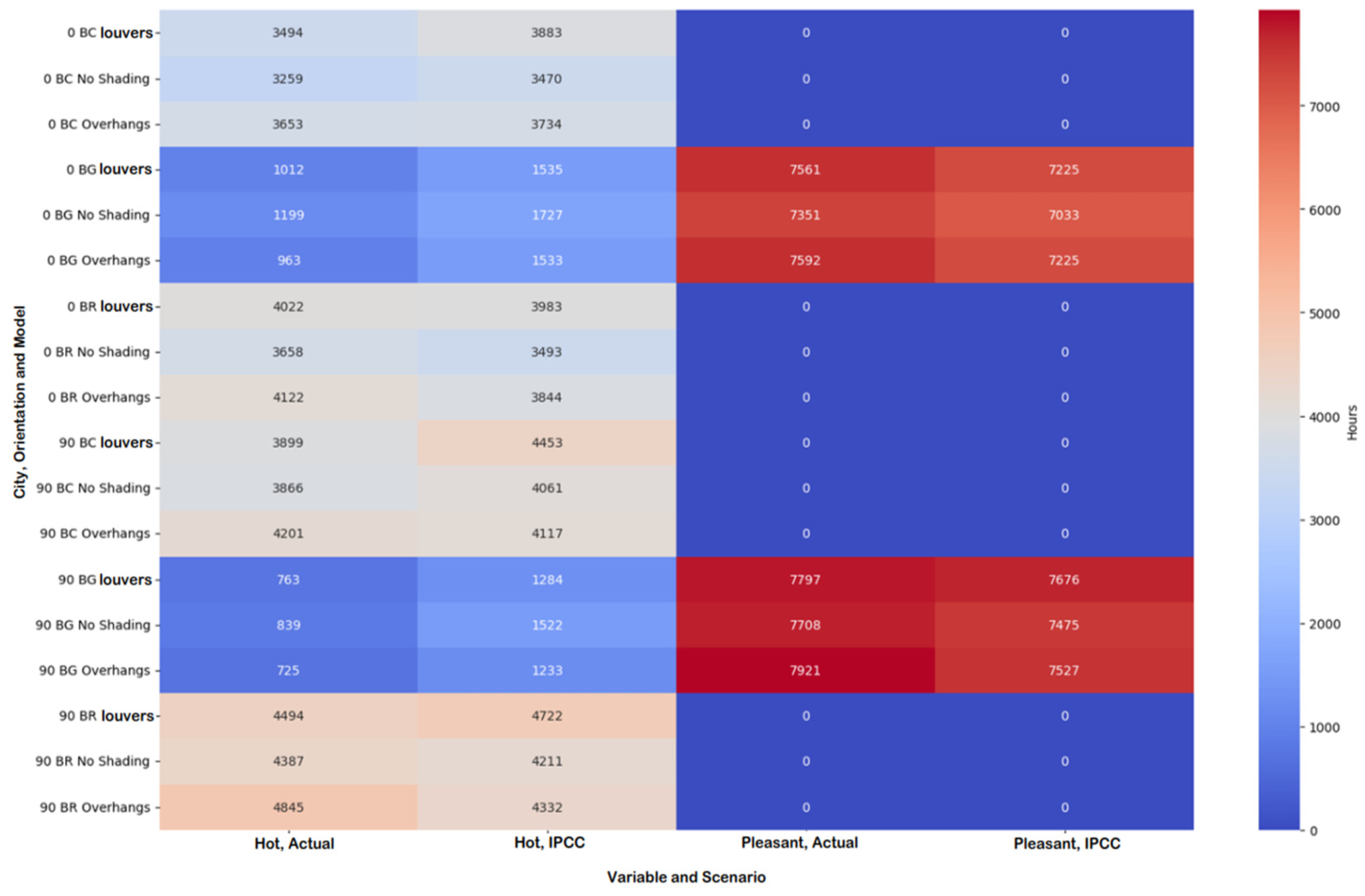
| Measure | Range | Error | Resolution |
|---|---|---|---|
| Indoor temperature | −40–60 [°C] | +0.1 [°C] | 0.1 [°C] |
| Outdoor temperature | −40–60 [°C] | +0.1 [°C] | 0.1 [°C] |
| Indoor humidity | 10–99% | +5% | 1% |
| Outdoor humidity | 10–99% | +5% | 1% |
| Channel | Code | Location |
|---|---|---|
| Channel 1 | (EEX21) | East zone, external wall, upper floor |
| Channel 2 | (EI22) | East zone, internal wall, upper floor |
| Channel 3 | (OI23) | West zone, internal wall, upper floor |
| Channel 4 | (OEX24) | West zone, external wall, upper floor |
| Channel 5 | (EEX15) | East zone, external wall, ground floor |
| Channel 6 | (EI16) | East zone, internal wall, ground floor |
| Channel 7 | (II17) | Central zone (intermediate area of the house) |
| Channel 8 | (OI18) | West zone, internal wall, ground floor |
| Data Set | R2 | Intercept (a) | Slope (b) | CV_RMSE | Mean_Temp | Xc | Residual_SE |
|---|---|---|---|---|---|---|---|
| Zone 1 | 0.9386 | 3.2388 | 0.8807 | 0.72% | 26.13 °C | 27.15 | 0.19 °C |
| Zone 2 | 0.9935 | 1.7033 | 0.9372 | 0.31% | 29.54 °C | 27.12 | 0.10 °C |
| Zone 3 | 0.8067 | 4.7755 | 0.8427 | 1.67% | 29.47 °C | 30.36 | 0.49 °C |
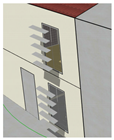 | Louvers (L) | n = 2 (L − 2) | 0.1 m (a) | 0.15 m (b) | 0.25 m (c) | |
| n = 5 (L − 5) | 0.1 m (a) | 0.15 m (b) | 0.25 m (c) | |||
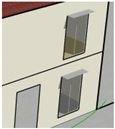 | Overhangs, windows (OW) | 0.1 m (a) | 0.15 m (b) | 0.25 m (c) | 0.5 m (d) | |
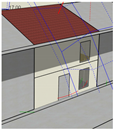 | Overhangs, façade (OF) | 0.3 m (a) | 0.5 m (b) | 1 m (c) | ||
 | Side fins (SF) | 0.1 m (a) | 0.15 m (b) | 0.25 m (c) | 0.5 m (d) | |
 | Louvers + side fins | 0.1 m (L − 2 + SFa) | 0.15 m (L − 2 + SFb) | 0.25 m (L − 2 + SFc) | ||
| 0.1 m (L − 5 + SFa) | 0.15 m (L − 5 + SFb) | 0.25 m (L − 5 + SFc) | ||||
| Source | Df | Sum Sq | Mean Sq | F Value | Pr(>F) | Sign |
|---|---|---|---|---|---|---|
| LOCATION (LOC) | 4 | 1.60 × 1010 | 4.10 × 109 | 1.70 × 104 | 0.00 × 100 | *** |
| CLIMATE (CLI) | 1 | 6.10 × 108 | 6.10 × 108 | 2.50 × 103 | 1.20 × 10−264 | *** |
| STRATEGY (STR) | 7 | 9.50 × 107 | 1.40 × 107 | 56.62 | 3.30 × 10−67 | *** |
| ORIENTATION (ORI) | 3 | 4.30 × 108 | 1.40 × 108 | 600.54 | 3.00 × 10−214 | *** |
| LOC:CLI | 4 | 1.20 × 108 | 2.90 × 107 | 120.29 | 3.10 × 10−82 | *** |
| LOC:STR | 28 | 2.50 × 107 | 9.10 × 105 | 3.78 | 2.90 × 10−10 | *** |
| LOC:ORI | 12 | 7.20 × 107 | 6.00 × 106 | 24.9 | 1.50 × 10−48 | *** |
| Residuals | 900 | 2.20 × 108 | 2.40 × 105 | NA | NA | |
| Total | 959 | 1.80 × 108 | NA | NA | NA |
| Source | Df | Sum Sq | SS % | Mean Sq | F value | Pr(>F) | Sign |
|---|---|---|---|---|---|---|---|
| LOCATION (LOC) | 3 | 4.60 × 109 | 74.72% | 1.50 × 109 | 5.10 × 103 | 0.00 × 100 | *** |
| CLIMATE (CLI) | 1 | 7.10 × 108 | 11.48% | 7.10 × 108 | 2.30 × 103 | 2.70 × 10−233 | *** |
| STRATEGY (STR) | 7 | 1.10 × 108 | 1.84% | 1.60 × 107 | 53.85 | 2.60 × 10−62 | *** |
| ORIENTATION (ORI) | 3 | 5.00 × 108 | 8.05% | 1.70 × 108 | 549.25 | 9.60 × 10−189 | *** |
| LOC:CLI | 3 | 1.50 × 107 | 0.25% | 5.10 × 106 | 17.01 | 1.10 × 10−10 | *** |
| Residuals | 750 | 2.30 × 108 | 3.66% | 3.00 × 105 | NA | NA | |
| Total | 767 | 6.20 × 109 | 100.00% | NA | NA | NA |
| Strategy | Mean Value | |||||
|---|---|---|---|---|---|---|
| 2-blade louvers + side fins (L2 + SF) | 9385.29 | a | ||||
| Overhang, windows (OW) | 9349.78 | a | b | |||
| Side fins (SF) | 9347.52 | a | b | |||
| 2-blade louvers (L2) | 9242.59 | a | b | |||
| No shading (reference case) | 9033.61 | b | c | |||
| 5-blade louvers + side fins (L5 + SF) | 8946.82 | c | ||||
| Overhang, façade (OF) | 8679.14 | d | ||||
| 5-blade louvers (L5) | 8247.23 | e | ||||
| Significance level α = 5% |
Disclaimer/Publisher’s Note: The statements, opinions and data contained in all publications are solely those of the individual author(s) and contributor(s) and not of MDPI and/or the editor(s). MDPI and/or the editor(s) disclaim responsibility for any injury to people or property resulting from any ideas, methods, instructions or products referred to in the content. |
© 2025 by the authors. Licensee MDPI, Basel, Switzerland. This article is an open access article distributed under the terms and conditions of the Creative Commons Attribution (CC BY) license (https://creativecommons.org/licenses/by/4.0/).
Share and Cite
Ascanio, J.; Álvarez-Sanz, M.; Azkorra-Larrinaga, Z.; Terés-Zubiaga, J. The Role of Solar Gains in Net-Zero Energy Buildings: Evaluating and Optimising the Design of Shading Elements as Passive Cooling Strategies in Single-Family Buildings in Colombia. Sustainability 2025, 17, 1145. https://doi.org/10.3390/su17031145
Ascanio J, Álvarez-Sanz M, Azkorra-Larrinaga Z, Terés-Zubiaga J. The Role of Solar Gains in Net-Zero Energy Buildings: Evaluating and Optimising the Design of Shading Elements as Passive Cooling Strategies in Single-Family Buildings in Colombia. Sustainability. 2025; 17(3):1145. https://doi.org/10.3390/su17031145
Chicago/Turabian StyleAscanio, Javier, Milagros Álvarez-Sanz, Zaloa Azkorra-Larrinaga, and Jon Terés-Zubiaga. 2025. "The Role of Solar Gains in Net-Zero Energy Buildings: Evaluating and Optimising the Design of Shading Elements as Passive Cooling Strategies in Single-Family Buildings in Colombia" Sustainability 17, no. 3: 1145. https://doi.org/10.3390/su17031145
APA StyleAscanio, J., Álvarez-Sanz, M., Azkorra-Larrinaga, Z., & Terés-Zubiaga, J. (2025). The Role of Solar Gains in Net-Zero Energy Buildings: Evaluating and Optimising the Design of Shading Elements as Passive Cooling Strategies in Single-Family Buildings in Colombia. Sustainability, 17(3), 1145. https://doi.org/10.3390/su17031145







